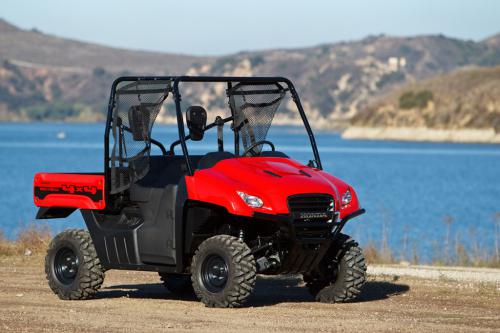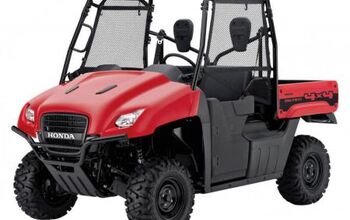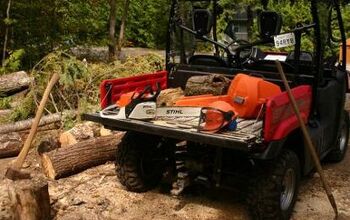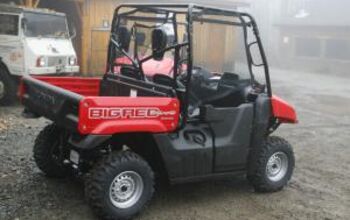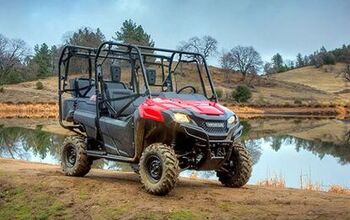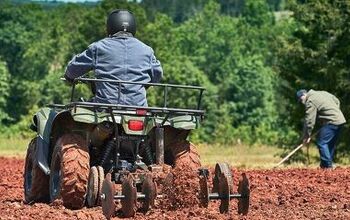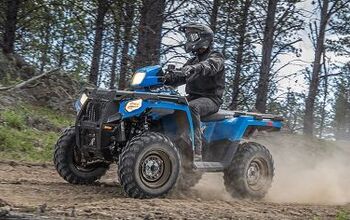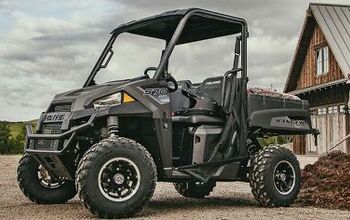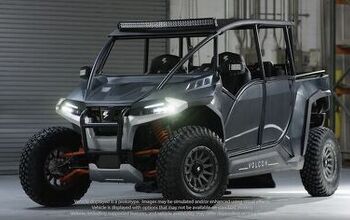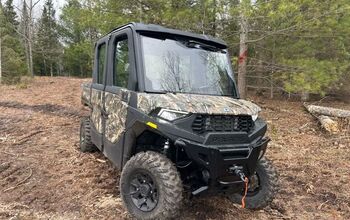2011 Honda Big Red MUV Review
Honda’s new 2011 Big Red doesn’t appear to be changed until you take a closer look at the unit’s updated features. We were given this opportunity during the press introduction in Irvine Lake, Calif.
Cosmetically the first thing we noticed as we approached the new unit was the updated single bench seat rather than the former dual bucket seats. Despite the single seat the passenger capacity for the Big Red has not been changed despite commonly associating the wider seat with the ability to seat three people. This seat is made from durable black rubber and dense cushion foam and has an adjustable back rest for additional passenger comfort.
In order to accommodate the new seat Honda’s engineers had to move the location of the parking brake handle. It was formerly located between the two bucket seats and is now on the panel directly below the centre of the bench seat. This parking brake system has been designed to hold the unit in any off-road situation with or without a load on.
2011 Honda Big Red MUV
With a simulated track built for us we was able to test out this claim. With a full load in the rear dump bed of 1000 pounds (an increase of 500 pounds from the previous generation) we parked the unit on an uphill incline of 35 degrees followed by a decline of 35 degrees. In both situations the parking brake held the unit in place with no movement at all. You were more likely to have the Big Red slide down the hill than having it roll.
It may be a utility vehicle first, but the Big Red is no slouch when it comes having some sporty fun.
Getting into that new seat is now easier thanks to the new roll-up nets on either side of the cab. Quick release clips allow you to roll the nets up and out of the way. Doing this while standing outside the vehicle is uncomplicated and, with the new quick-release clips on the nets, this task from a sitting position is simple as well. This design is an improvement over the last generation where the nets couldn’t be entirely removed without tools and a bit of a hassle. I was also a hassle to have to get in and out the old Big Red with the nets in the way.
Aside from the major cosmetic differences there have been some mechanical changes as well. One thing that remained unchanged was the engine. The 675cc liquid-cooled single cylinder Honda powerplant puts out plenty of power for working or trail-riding.
Attached to this engine is Honda’s automotive-style automatic transmission which offers three forward gears and a single reverse gear. This set-up uses a hydraulic torque converter and an ECM (electronic control module) to monitor engine performance and choose optimum gear position.
A little mud was no match for the Big Red
The gears felt “long” when we were driving the Big Red around the mountains in southern California. They seemed to shift a lot later than we anticipated them too but an engineer reminded us that with the three gears this is to be expected. However, low-end torque was still plentiful and the motor would downshift when you stepped on the throttle to make up for the wider powerband.
The 2011 Big Red has increased it’s towing capacity to 1,500 pounds Honda had a 1,300-pound trailer on hand to let us feels this power. With the trailer behind me the unit didn’t seem to even struggle when accelerating or manoeuvring around the trails.
With the load in the trailer nearing the 1,433-pound curb weight of the machine we were a little worried about the braking capabilities while traveling at speed. The 200mm hydraulic discs front and rear combined with the tread pattern on the Maxxis Big Horn tires brought the unit to a safe stop with little or no sliding.
The engineers had one Big Red loaded up with the new 2011 capacity of 1,000 pounds and after our test drive with the trailer we had an interesting idea. Approaching the engineers we sheepishly and half jokingly asked if we could hitch the trailer up to the unit with the fully loaded bed and take it out for a drive. After sharing some initial concerned glances amongst each other they told us to “go for it.”
We shifted the unit into drive with more than a few curious eyes on us and rolled down the trail. From the standpoint of power we found that the unit accelerated and pulled the load almost unnoticed aside from hearing the engine working harder and the transmission shifting longer (both of which were expected). One surprise was that the steering wasn’t affected the way we had anticipated. We felt confident enough to get the machine up to a respectable 20 mph on the road/trail portion of the test facility.
We were impressed that Honda had the confidence to allow us to go out with the bed and the trailer at or near full capacity.
The couple of bumps and bounces in this trail portion scared us a bit. We were worried about bottoming out the suspension when traveling at higher speeds. Much to our surprise the independent double-wishbone suspension with variable-damping shock absorbers and 7.1 inches of travel in the rear (5.9 inches on the front) ate up the bumps even with the full load weighing it down.
Even with 1,000 pounds in the bed the suspension soaked up the bumps in the trail without bottoming out.
We’ve driven MUVs with trailers before so we knew what to expect when hitting the brakes with this load behind the Big Red. The trailer pushed despite the slowing action and caused the rear end to slide a little sideways. We did do one emergency-style stop to feel the unit’s capability and aside from a bit of a slide we found that if you keep steering with the slide the Big Red was able to get stopped safely and quickly.
At no point were we worried about pushing it too far. The ROPS (roll over protection structure) on the Big Red is certified to meet the requirements of OSHA (occupational safety and health administration).
When we brought the unit back to the corral area we brought up an interesting point with the engineers. When making a number of slow-speed turns we found that thanks to the unit’s tight turning radius of 13.8 feet we were able to jack-knife the trailer going forward. This was during extremely tight turns you wouldn’t normally have to make with a trailer but it’s something to note – If you crank the wheel you’re going to rub your tires on the trailer tongue.
Operating the Big Red was very simple with ergonomically designed controls in the cab. The dashboard features two levers for selecting between forward, neutral, and reverse as well as 2WD, 4WD, and a fully locked differential 4WD mode. A small digital gauge is located directly above the steering column and gives the driver information such as speed, gear position, and parking brake activation warning. Keeping you strapped to the seat are the automotive style three-point ELR (emergency locking retractor) seat belts and ergonomically placed footwells which help brace the rider on bumpy trails. Other features in the cab include a 12V power outlet for accessories and a lockable waterproof glove box.
With the safety nets latched and the seatbelts secured we had no worries about our well being while pushing the Big Red to its limits.
Other accessories can be put on the Big Red strait out of the factory. Some of the units on our test ride came equipped with these accessories so we got a good idea of how well they worked. Optional roofs, windshields, and half-windshields give the Big Red the appearance of a fully enclosed cab and provide superior protection from the elements. The windshield option was excellent for keeping dust out of your face while riding and the roof provided a well needed break from the sun for both our heads and the black rubber seat.
Some of the utility accessories were also available for us to test. Front and rear bumpers protect the unit against damage and optional spotlights provide more light when you’re working or riding at night. Optional rails that are attached to the pneumatic assist dump bed floor provide you with additional points to strap down cargo. Also available for the bed is an optional gear bag sized to fit perfectly in the area directly behind the cab so it doesn’t limit your ability to load the unit at the rear with the truck-style tailgate.
The Big Red felt stable and secure on off-camber sections of the trail.
Back on the trail the size of the 2011 Big Red made manoeuvring easy for our group. Overall dimensions of 114 inches long, 64 inches wide, and 76.9 inches tall made sliding through rocky hills and dense forest sections simple. This ride was also possible with the unit’s 10.3 inches of ground clearance for getting over those rough sections without getting hung up or damaging the under body.
A steep side-hill portion of the trail let the Big Red show off its low center of gravity and stable riding stance. We took the fully loaded unit across this section of the trail and were surprised to find that aside from a little slipping of the rear wheels the unit felt solid on the steep incline. This was quite a relief with the lake looming menacingly down the hill below us.
The 2011 update on the Big Red focused on beefing up the already impressive machine with increased payload capabilities and increased towing capacities. Overall we feel that this unit is ready to work on a farm or property but the rider could still go out and have some fun on the trails when the work is done.
The suspension and low center of gravity worked together to keep us from rolling down into the lake.
Comparable Vehicles: Arctic Cat Prowler 700 H1, Can-Am Commander 800R, Kawasaki Teryx 750, Polaris Ranger 800 XP, Yamaha Rhino 700 FI
Related Reading
More by ATV.com Staff



